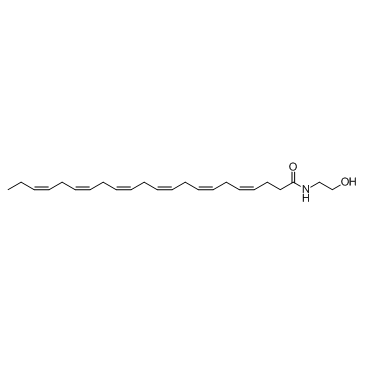Synaptamide (Dehydroepiandrosteron(DHEA)) (Synonyms: DEA, DHEA, Synaptamide) |
| Catalog No.GC30815 |
An endocannabinoid found in brain and retina
Products are for research use only. Not for human use. We do not sell to patients.

Cas No.: 162758-94-3
Sample solution is provided at 25 µL, 10mM.
Docosahexaenoic Acid (DHA) is an essential fatty acid and the most abundant ω-3 fatty acid in neural tissues, especially in the retina and brain. Docosahexaenoyl ethanolamide (DHEA) is the ethanolamine amide of DHA that has been detected in both brain and retina at concentrations similar to those for arachidonoyl ethanolamide (AEA).[1],[2] A 9.5 fold increase of DHEA was observed in brain lipid extracts from piglets fed a diet supplemented with docosahexaenoic acid (DHA) compared to a control diet without DHA.[3] DHEA binds to the rat brain CB1 receptor with a Ki of 324 nM, which is approximately 10-fold higher than the Ki for AEA.[4] DHEA inhibits shaker-related voltage-gated potassium channels in brain slightly better than AEA, with an IC50 of 1.5 µM.[5]
Reference:
[1]. Sugiura, T., Kondo, S., Sukagawa, A., et al. Transacylase-mediated and phosphodiesterase-mediated synthesis of N-arachidonoylethanolamine, an endogenous cannabinoid-receptor ligand, in rat brain microsomes. Comparison with synthesis from free arachidonic acid and ethanolamine. European Journal of Biochemistry 240, 53-62 (1996).
[2]. Bisogno, T., Delton-Vandenbroucke, I., Milone, A., et al. Biosynthesis and inactivation of N-Arachidonoylethanolamine (Ananadamide) and N-Docosahexaenoylethanolamine in bovine retina. Archives of Biochemistry and Biophysics 370(2), 300-307 (1999).
[3]. Berger, A., Crozier, G., Bisogno, T., et al. Anandamide and diet: Inclusion of dietary arachidonate and docosahexaenoate leads to increased brain levels of the corresponding N-acylethanolamines in piglets. Proceedings of the National Academy of Sciences of the United States of America 98(11), 6402-6406 (2001).
[4]. Sheskin, T., Hanus, L., Slager, J., et al. Structural requirements for binding of anandamide-type compounds to the brain cannabinoid receptor. Journal of Medicinal Chemistry 40, 659-667 (1997).
[5]. Poling, J.S., Rogawski, M.A., Salem, N., Jr., et al. Anadamide, an endogenous cannabinoid, inhibits shaker-related voltage-gated K+ channels. Neuropharmacology 35(7), 983-991 (1996).
Average Rating: 5 (Based on Reviews and 31 reference(s) in Google Scholar.)
GLPBIO products are for RESEARCH USE ONLY. Please make sure your review or question is research based.
Required fields are marked with *




















